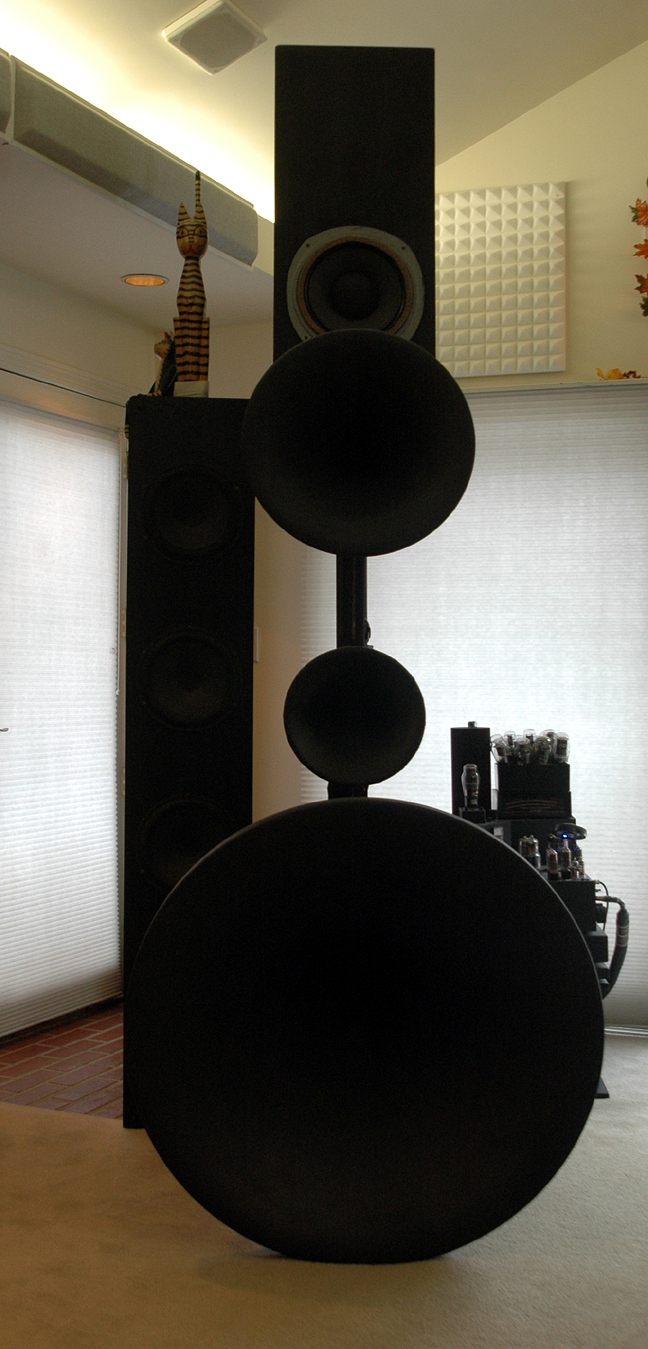|
fiogf49gjkf0d
Yes, I promised to tell about, so here is comes.
The past Sunday I woke up at 6AM and first intention to answer to myself what is wrong with my ULF. I had wonderful sound with absolutely wonderful and the most important very proper bass. However all my attempts to supplement my bass with ULF took sound in very wrong direction? As soon I added go 1/5 dB of ULF over my bass output the wait and the size of presentation was imidetaly growing but the leading edge of the midbass and bass notes got very severally defused and become non expressive. I did find a good balance between some added weight from the bottom and destruction of my midbass but it was near close what I would like to be, so I mostly prefect to hear my playback without ULF – it was very-very musical and nice presentation.
I was wondering why my woofer towers stopped working, they were working spectacularly in my old room. I turn the playback on, crank my ULF for extras 3 dB and was listening what is doing on. I was paying attention to the deformity of midbass across midbass range. What I noticed is that lower midbass is got screwed differently then mid midbass and then upperbass again got screwed. It has to be timing related I figured.
I moved my ULF towers exactly under the driver of my midbass horns. The change was very interesting. The destruction of midbass still was there but it was very evenly dispersed across the whole midbass range. I kind of began to feel very idiotic about myself. Over the years I am very vocal and persistent advocate of prejudicial time aliment and not I was harvesting the crapy results because my ULF was not time aligned. There was however even more then time alignment. Over the year I made fun and humiliate the people who built “subwoofers in the corners” and now, putting my ULF woofer towers in basically another room I was essentially doing the very same. Yes, in that another room (look at the picture at the begging of the thread) the large woofer tower’s presence was absolutely not abusive but it is did not work for Sound.
So, what I did next was taking my woofer towers and the location where I use to have them for 11 years in my old room – on the outside side of Macondo in exact time-aligned position with the rest MF Macondo drivers. I turned the playback on and… had no ULF out at all. The drivers where moving but there was no sound – I need more gain I figured. In my old location I attenuated the ULF power amp for 8 clicks which is 24 dB. Not I max out my power amp and I only begin to have something. I opened up the ULF B2 amp and dropped feedback for 6 dB – not I have mode gain. The room’s bottom juts fallen off and it took in itself all it bass without exhibiting any sight of overload or any other negative experiences.
I would like to say that I did something smart – I did not. As soon I time-aligned the woofer towers and point then directly to the listening position then the Sound got instantly and automatically all sonic attributes that I was looking from ULF. I was extremely happy with result and very angry to myself for being such a fucking idiot and was trying to get some sound from a ULF configuration that I spend years to hate. I was so displeased with myself that I took the 4-wire 3Ga cable (fat and expensive) that my carpenter installed for me in the wall and pulled it out of the wall assuring the I have no more dedicated line from my equipment bay to my old location of the ULF towers.
Sure, I have some excuses. I ordered my woofer towers as a custom project from John Danlavy back in 2000. At that time John was contemplating the woofer towers as a commercial project, in fact become a commercial project by my tower were made with a lot of negotiations and debates. Since then I did not have any other bass in my room and this is the only bass I am accustomed for the last 11 years. I loved that bass from day # 1, in fact I so loved it that I got my second ML2.0 to drive my woofer towers. So, when I I put my woofer towers in the very same position as I has it in my old room I got instantly my old Marlborough Bass the I so loved and was so proud.
Interestingly that bass that I have from those woofer towers is much more advanced then what I had in my old room. In my all room my woofer towers were bass module as they handle mid and lowest bass. In my new room my woofer towers are thru ULF as midbass horns care all auditable sound. I very much the result and it only proves that all along my ranting about arrival-alignment, the latitude-alignment, the location of bass outside of MF and the rest of BS were very much accurate. Now, if I learn do what I pitch then I would same me so much aggravation, not only in audio BTW….
Here is the new location for my ULF of left chennal:

Rgs, Romy the Cat
"I wish I could score everything for horns." - Richard Wagner. "Our writing equipment takes part in the forming of our thoughts." - Friedrich Nietzsche
|